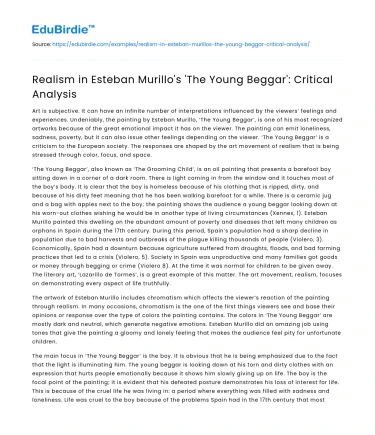Art is subjective. It can have an infinite number of interpretations influenced by the viewers’ feelings and experiences. Undeniably, the painting by Esteban Murillo, ‘The Young Beggar’, is one of his most recognized artworks because of the great emotional impact it has on the viewer. The painting can emit loneliness, sadness, poverty, but it can also issue other feelings depending on the viewer. ‘The Young Beggar’ is a criticism to the European society. The responses are shaped by the art movement of realism that is being stressed through color, focus, and space.
‘The Young Beggar’, also known as ‘The Grooming Child’, is an oil painting that presents a barefoot boy sitting down in a corner of a dark room. There is light coming in from the window and it touches most of the boy’s body. It is clear that the boy is homeless because of his clothing that is ripped, dirty, and because of his dirty feet meaning that he has been walking barefoot for a while. There is a ceramic jug and a bag with apples next to the boy; the painting shows the audience a young beggar looking down at his worn-out clothes wishing he would be in another type of living circumstances (Xennex, 1). Esteban Murillo painted this dwelling on the abundant amount of poverty and diseases that left many children as orphans in Spain during the 17th century. During this period, Spain’s population had a sharp decline in population due to bad harvests and outbreaks of the plague killing thousands of people (Violero, 3). Economically, Spain had a downturn because agriculture suffered from droughts, floods, and bad farming practices that led to a crisis (Violero, 5). Society in Spain was unproductive and many families got goods or money through begging or crime (Violero 8). At the time it was normal for children to be given away. The literary art, ‘Lazarillo de Tormes’, is a great example of this matter. The art movement, realism, focuses on demonstrating every aspect of life truthfully.
Save your time!
We can take care of your essay
- Proper editing and formatting
- Free revision, title page, and bibliography
- Flexible prices and money-back guarantee
The artwork of Esteban Murillo includes chromatism which affects the viewer’s reaction of the painting through realism. In many occasions, chromatism is the one of the first things viewers see and base their opinions or response over the type of colors the painting contains. The colors in ‘The Young Beggar’ are mostly dark and neutral, which generate negative emotions. Esteban Murillo did an amazing job using tones that give the painting a gloomy and lonely feeling that makes the audience feel pity for unfortunate children.
The main focus in ‘The Young Beggar’ is the boy. It is obvious that he is being emphasized due to the fact that the light is illuminating him. The young beggar is looking down at his torn and dirty clothes with an expression that hurts people emotionally because it shows him slowly giving up on life. The boy is the focal point of the painting; it is evident that his defeated posture demonstrates his loss of interest for life. This is because of the cruel life he was living in: a period where everything was filled with sadness and loneliness. Life was cruel to the boy because of the problems Spain had in the 17th century that most likely killed his parents and left him an orphan.
Space is an important element in every painting; the surroundings can help one interpret what the message of the art is. One can tell that the boy from the painting is located in an abandoned building since there is no furniture or other objects that show otherwise. In ‘The Young Beggar’, the surroundings of the young boy are a ceramic jug and a straw sack-like bag that has a few apples inside. Next to that there are leftovers that let the viewer know that the boy has been living there for a while. The area in which the young beggar is at demonstrates that there is a lack of objects emphasizing the state of living in where the boy finds himself in. It stresses the fact that he does not have a place to call home and that the space that surrounds him is filled with nothing but his own loneliness.
In conclusion, ‘The Young Beggar’, creates a significant emotional influence into what the viewers see. This is mostly because of the profuse amount of realism being depicted in the painting through the color, focus, and space. The dark colors, the boy being the focal point, and the surroundings were what helped back up the emotional impact the audience had. Esteban Murillo made this painting to criticize European society as it had many problems economically, socially, and politically.






 Stuck on your essay?
Stuck on your essay?

